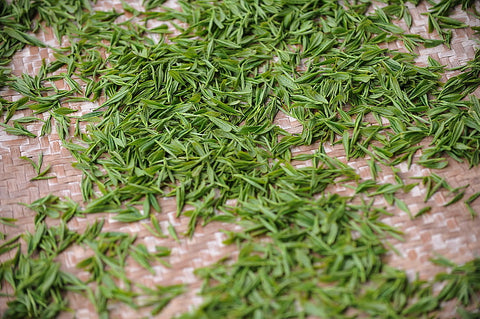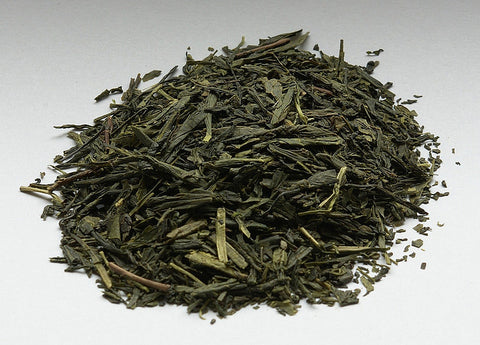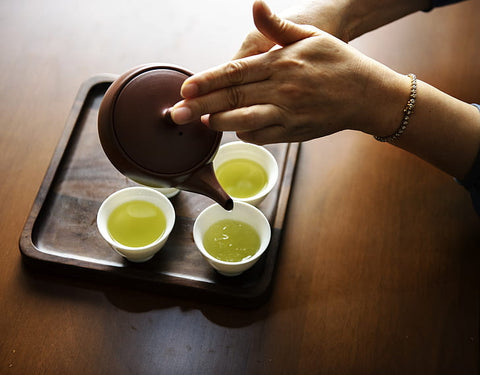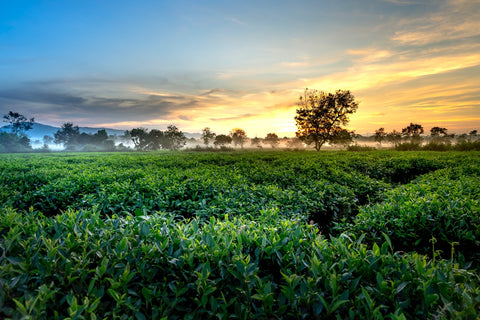A Guide to Japanese Green Tea
Not all green teas are the same. They are made of diverse, complex, and regional varieties. Japanese green tea alone has a myriad of tea selections that are unique in flavor, abundant in variety, and ingenious in production. They’re surprisingly composed of many of the world’s very best. Let’s take a deeper look at the different Japanese green teas, from sencha to matcha. You may just discover your new favorite cup of tea along the way.
All About Japanese Green Tea
A perfect example of man’s fascination in exploring Japanese tea is matcha.
Not long ago, this tea was considered uncommon but remained an expert’s choice. It was the only tea where you consumed the leaves and required the use of milling stones to specially-ground 30 grams (approximately an ounce) of leaves to produce fine matcha powder. Matcha was also very expensive and when served during Japanese tea ceremony rituals, it required a whisk, a scoop, and other tools needed for the ceremony. It was indeed a hidden treasure.
Nowadays, Japanese teas like shincha and kabusecha still remain hidden. You don’t see them abundantly on supermarket shelves. You have to seek out most of them. In 2019, Japan’s substantial tea production was considered the 9th largest in the world in terms of global sales from tea exports by country. Among the top exporters, Japan still remains one of the fastest-growing tea exporters since 2015.
The best varieties of Japanese teas are fastidious when it comes to brewing. There’s a narrow line between having just the right tea and having a less than pleasant one. Chinese and Indian teas are steeped for several minutes. But for Japanese teas like fukamushi sencha, they need an exact 45 seconds of steeping. Any longer and it starts becoming bitter, while asamushi sencha needs a whole minute of steeping before it’s going to taste unpleasant.
Check out this list of different types of Japanese green tea and see how intricate they’re obtained.
Sencha
This classic Japanese green tea is derived from leaves that grow under sunlight and harvested 88 days after the start of spring. It is made from the first harvest of the tea plant, thus sencha is made from young and tender buds. A fine sencha has a freshness in taste and a savory umami flavor. Every region cultivating and processing this type of tea adds their own flavors and production strength. The Uji region in Japan is noted for its range of excellent to spectacular Uji sencha tea.
Gyokuro
Known as the “jade dew”, gyokuro is one of the highest quality teas in the world and has a meticulous brewing process. The distinguishing rich aroma and expansive flavor come from being coddled by covers that shield it from sunlight as it nears its harvest time. The shaded gyokuro green tea undergoes a thorough process of hand selection of buds and a skill- and labor-intensive artisan processing at every stage, from cultivation to maturing.
Genmaicha
Genmaicha tea is also called “Japanese popcorn tea” because it’s genmaicha green tea with roasted brown rice. Gemaicha has a mild and sweet nutty flavor due to the sugar and starch in the rice. In olden times, brown rice was added as a filler to tea by the lower class Japanese since not everyone can afford the real thing. This poor man’s tea remains popular as a stomach-friendly and an easy-to-drink beverage. There are also high quality genmaichas blended with matcha powder.
Kukicha
This aromatic tea is made from the “waste products of tea production” – the stems, stalks, and twigs of the Camellia Sinensis plant. Twig kukicha tea is usually processed just like how the green tea leaves are processed, including the steaming step to finish them. There are a number of kukicha tea varieties in the market today. Kukicha teas are also lauded for their health benefits. Normally, they produce a light cup of mild nutty undertones to a light green tea flavor, with a slightly creamy sweet flavor.
Houjicha
This toasty, caramel-like flavored tea replaces the typical vegetative undertones of Japanese green teas. Hojicha is roasted in a porcelain pot over charcoal with an appeal similar to green teas but without the grassy taste that some people find unappealing. Hojicha tea is gaining popularity outside Japan and could build a strong niche among tea lovers.
Kabusecha
This is the only sencha that is shade grown. A week or two before harvesting, the plants are covered to block off sunlight from reaching the plants. As a result, the sencha is mellower. It has merits of fine sencha as well, but it is sweeter, more vegetal, and less grassy. Because it’s shaded less than gyokuro, this excellent tea is less pricey but comparable to gyokuro’s fine quality. Kabusecha tea is the midpoint between sencha and gyokuro, meaning it has gyokuro’s sweetness and sencha’s refreshing taste.
Shincha
This “new tea” is very expensive and is not readily available in the supermarket shelves. The process of obtaining shincha involves picking the first sencha leaves of the season. These new leaves are higher in amino acids, giving sencha a fresh, sweet taste. They are also lower in caffeine content and catechin compounds, the chemicals that add astringency to tea. Shincha tea also has a smooth umami character in its flavor.
Bancha
This is a lower grade sencha also known as “common tea”. It is usually harvested in summer and autumn. The discarded parts of the plant when making sencha are the ones used in making bancha. This consists of large, coarse leaves and stems. If you’re looking for brisk teas you can drink through the day, try bancha tea. This green tea is inexpensive and is considered an equivalent to the mass produced ones in the market. Bancha has a less aromatic aroma but has a robust flavor that goes well with food.
Japanese Green Tea Varieties

Japanese tea growing has made its mark throughout history. It is known for its precision, innovation, efficiency, waste reduction, and creation of multitudes of flavors from a narrow range of cultivars, the cultivated tea plant varieties.
According to a publication in 2010, Japan’s tea fields house 77% of the Yabukita clonal bush. This clonal propagation began in the 1950s. These clonal tea bushes are grown from hybrid clones and not from seeds. A great percentage of the harvest, around 80%, goes to making sencha. In turn, sencha provides the foundation for a number of Japan’s other premium teas.
The combinations of seedlings and other hybrid cultivars bred from Yabukita tailor the bushes to regional climate, soil, and harvesting methods. This adds subtleness to the flavor and aroma to the tea. With this method of cultivation and propagation, it offers an abundance of choices when it comes to finding the types of teas that offer something special to your liking.
Japanese Green Tea-Making Process

Unlike black teas and oolong teas, the major characteristic of green teas is that they are not oxidized. Oxidation in teas involves the interaction of oxygen with the molecular compounds of tea leaves. With green tea leaves, they are not completely exposed to air, thus blocking the oxygen from interacting with the leaves. As a result, the tea leaves release amino acids and build catechins that give green teas their light flavor and various health benefits. Black teas, on the other hand, undergo full oxidation that builds the tannins. Tannins provide the body and astringency of black teas and oolong teas.
The main difference between Japanese and Chinese green teas is that Japanese tea growers steam the harvested crop to arrest oxidation, typically around 20 to 40 seconds. The Chinese method involves pan-frying the harvested tea leaves.
The Japanese steam methods produce very small leaves that are flattened, kneaded, ruffled, rolled, and straightened to form bright green needle-shaped leaves. By doing this stimulating process, the release of flavors when brewing tea is fast and smooth. It also brings out the umami flavor: the brothy, savory vegetal taste that remains in the mouth and on the tongue when you drink green tea. Umami is now considered as the fifth taste group, along with sweet, sour, salty, and bitter.
How Japanese Green Teas Are Different

When it comes to the comparison of Chinese pan-fried teas and Japanese steam-dried teas, there is a great extent of comparison in terms of flavors, styles, aromas, textures, and aftertaste. It is nearly impossible to come into a convincing generalization.
For the sake of contrast, here’s one example. Japanese green teas have smooth, clean, and clear taste. Chinese green teas are multidimensional and you need to bring attention and judgment to find their intricacies. An estimated 600 green tea cultivars produce green tea in China but only one dominates in Japan.
This proposes that there’s a narrow unidimensionality among Japanese teas: Yabukita (one variety), steaming (one processing method), sencha (one type), and needle (one leaf). Coming from a single base green tea, which is sencha, Japanese green tea is distinguished by subtleties by means of the following: (1) seasonal timings of harvest across microclimates, (2) the number of seconds of “kill-fixing” oxidation, and (3) refining the base crop output to create the premium categories.
Even high-end Japanese teas only have two differing paths during cultivation and propagation: the sun-grown and the shade-grown. Examples of two major shade teas are matcha and gyokuro, but these green teas are still derived from sencha. The tea bushes are covered for weeks or days before harvesting. This process shades the leaves from the sun’s radiation. This brings out the chlorophyll and a chock full of L-theanine is packed in the leaves. L-theanine, a wonder compound, is known to have a positive impact on the mood and brain function, creating a relaxing and calming feeling.
Japanese Green Tea Grower Regions

Throughout Japan, tea is widely grown with four large prefectures dominating the market and twenty areas of note within them. Here are the four green tea grower regions in Japan.
Shizuoka: This region produces 40% of Japan’s green tea, mostly Shizuoka sencha. It is very advanced in terms of research, mechanization, and production methods. It comprises stronger tea flavors with its hilly terrain and brisk coastal climate. This region is equally reputed for tea quality and range.
Kagoshima: Located in the far south on the island of Kyushu, Kagoshima is the 2nd largest producer of tea, with the broadest varieties. The teas from this region are some of the best options for consumers. They’re of good quality and are reasonably priced. The innovation used is also accelerating. The teas here are richer and fuller in flavor compared to most of the other regions. The climate is warm and humid most times of the year. Because it enables 5 harvests, this region increasingly produces some of the most interesting local teas you’ll find.
Uji: This region is located in the Kyoto Prefecture, the historical center of Japan’s tea growing. This region only produces 3% of Japan’s green tea. Among the green teas harvested here are the sencha, gyokuro, and matcha. It has the highest reputation when it comes to the matcha variety but also has superb sencha and wonderful Uji gyokuro variety.
Fukuoka: Remember the type of green tea that is considered one of the highest qualities in the world? This region produces half of Japan’s gyokuro. This green tea is expensive due to the fact that it needs a lot of work, skill, and labor to produce the “jade dew.” The dento hon gyokuro, a competition grade tea in the Yame area of Fukuoka, is said to cost $50 an ounce or $4 a cup. Gotta pay through the nose for a cup of gyokuro. This type of tea is not widely exported abroad.
The Takeaway
Now you have everything you need to know about the different types of Japanese green tea. When buying one, whether you’re into matcha green tea or bancha green tea, purchase from a reliable tea supplier or producer that believes in ethical tea farming and has solid knowledge about the cultivation, propagation, processing, and preparation of different types of Japanese green tea.
References:
Just One Cookbook | My Recipes | Tea in Spoons | The True Japan
